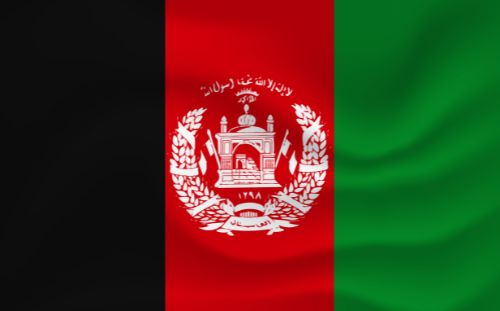Table of Contents
The Afghanistan flag is an important national symbol of the country. It has a rich history and deep meaning that is tied to the identity of Afghanistan and its people. This article will explore the origin of the flag, explain its meaning, and present some facts about it.
The design of the Afghanistan flag is inspired by ancient flags in Central Asia and features three colors: black, red, and green. The colors represent different aspects of Afghan culture and history such as bravery, peace, unity, pride, sacrifice, independence, and freedom.
The Islamic crescent moon on top adds a religious element to the flag’s symbolism. Overall, the Afghanistan flag is a powerful symbol that represents not only the nation but also its spirit and values.

The Origin Of The Afghanistan Flag
The Afghanistan flag was adopted in 2013, replacing a previous flag that had been in use since 2004. It is composed of three colors: black, red, and green. The colors are believed to represent the country’s history and culture, with black being for the past, red for the present, and green for the future. The top left corner of the flag features a white crescent moon and star, which are symbols of Islam. The nation’s coat of arms is also featured prominently in the center of the flag.
The new design was intended to help unify Afghanistan’s diverse population and provide a sense of national pride. Since its adoption in 2013, it has become an important symbol representing Afghanistan internationally. It is proudly displayed throughout the country on buildings, monuments, public spaces, and apparel.
The Colors And Symbols Of The Flag
The Afghanistan flag is a tricolor of black, red, and green. Black symbolizes the dark past of the country, while red stands for its courage and martyrdom. Green is associated with Islam and hopes for the future of Afghanistan. The national emblem sits in the center of the flag, showcasing an Islamic mosque surrounded by two flags and sheaves of wheat. This imagery speaks to both the history and faith of the Afghan people.
The white crescent moon on top of the mosque is symbolic of progress, peace, and prosperity in Afghanistan. The four stars represent justice, truthfulness, freedom, and loyalty to Islam. Together they form the Pan-Islamic colors that are often used in many Muslim countries throughout Asia. This powerful combination serves as a reminder to Afghans that their collective history gives them strength in difficult times.
The Meaning And Significance Of The Flag
The colors and symbols of the flag of Afghanistan represent the nation’s history, culture, and religious beliefs. The three colors black, red, and green are traditional Afghan colors and along with the white crescent moon in the center of the flag also symbolize Islam. The national flag of Afghanistan was officially adopted on August 19th, 2013 as part of a new government led by President Ashraf Ghani.
The symbolism behind the Afghan flag is deeply rooted in Afghan national identity. The black color signifies both courage and strength while red symbolizes justice and progress. The crescent moon is a representation of Islam which is practiced by most Afghans, while green symbolizes prosperity, faith, solidarity and peace. As such, the colors and symbols of the Afghan flag represent a commitment to preserving its national identity while striving for unity within its borders.
Interesting Facts About The Flag
The national flag of Afghanistan was adopted in the year 2004. It is a tricolor consisting of three vertical bands of black, red, and green. The black color on the flag represents Afghanistan’s troubled past and the sacrifices made by its people. The red color symbolizes their strength and bravery while the green color stands for hope and peace.
The Afghan flag also features a mosque-like emblem in white at its center which is known as the Pul-i-Alam or Flagpole of Alam. According to legend, it commemorates an 18th-century battle won by Ahmad Shah Durrani against the Mughal Empire. The mosque’s four minarets represent his four sons while its dome symbolizes his own greatness and power over his enemies. This emblem has since become a powerful symbol of Afghan culture and pride throughout Afghanistan and beyond.
How The Flag Is Used Today
The flag of Afghanistan has been used to represent the country since its independence in 1919. It is a tricolor, with three vertical bands in black, red, and green. The black band represents the people of Afghanistan, while the red stands for their bravery and valor in battle. The green is symbolic of Islam, and it also represents prosperity and joy.
The flag is an important symbol for Afghans today and can be seen at major political rallies and ceremonies throughout the country. It is flown alongside other flags during Independence Day celebrations to show patriotism and love for one’s nation. The flag is also displayed on buildings around the country as a sign of respect toward the Afghan nation, its constitution, citizens, culture, language, religion, and customs. As such, it serves as a reminder that Afghans are united by their shared values and principles regardless of their ethnic or religious backgrounds.
Frequently Asked Questions
How Long Has The Afghanistan Flag Been In Use?
The Afghanistan flag has been in use since 1709 when it was adopted by Ahmad Shah Durrani, the founder of the Afghan Empire. Since then the flag has remained relatively unchanged and is still used today to represent Afghanistan and its people. It is a tricolor featuring three horizontal stripes of black, red, and green with a white crescent moon and a five-pointed star in the center.
Are There Any Other Versions Of The Afghanistan Flag?
Yes, there are other versions of the Afghanistan flag. The original Afghanistan flag dates back to 1880 and is comprised of a vertical tricolor stripe of black, red, and green with a white crescent moon in the center. It was adopted as the official national flag in 2004, but several variations exist. The most common variation is a simplified version with only three horizontal stripes of black, red, and green, while another features the same stripes in a vertical configuration. There is also an older version that includes two extra stripes at the bottom of yellow and white.
What Is The Official Protocol For Displaying The Afghanistan Flag?
The official protocol for displaying the Afghanistan flag is to raise it on a flagpole with the white star facing up. The flag should be hoisted slowly and respectfully and lowered quickly in a dignified manner. When displayed with other flags, it should be at the same height and flown at the same speed. It should never be allowed to touch the ground or trail in the water. Additionally, no other objects should ever be placed on top of the Afghanistan flag.
How Has The Afghanistan Flag Evolved Over Time?
The Afghanistan flag has changed over the years since it was first adopted in 1928. Initially, it had three stripes of black, red, and green with a crescent moon and star in the center. In 2004, a new design was adopted that featured the same colors but with an added white stripe at the top. The crescent moon was also moved to the upper left corner and two additional stars were added to symbolize Afghanistan’s unity and peace. This design has remained unchanged since then, becoming an enduring symbol of Afghanistan’s history and culture.
What Is The Ratio Of The Afghanistan Flag?
The current Afghanistan flag has a ratio of 3:2, with three equal vertical strips of black, red, and green, respectively. The central white stripe is twice the width of the other stripes, and it has a stylized version of the Islamic Shahada in its center. In addition, there are four symbols in each corner – an AK-47 assault rifle, a mujahideen flag, a Dari poem, and finally an illustration of the mosque at Mazar-i-Sharif.
Conclusion
The Afghanistan Flag has been in use for centuries, and its evolution over time is fascinating. It has had several versions throughout its history, but the current version remains unchanged. The correct protocol for displaying the Afghanistan Flag is to ensure that it is flown with a 2:3 ratio. I think it’s amazing that this flag, which represents a nation with such a long and rich history, still stands today as a symbol of national pride and hope for the future.
